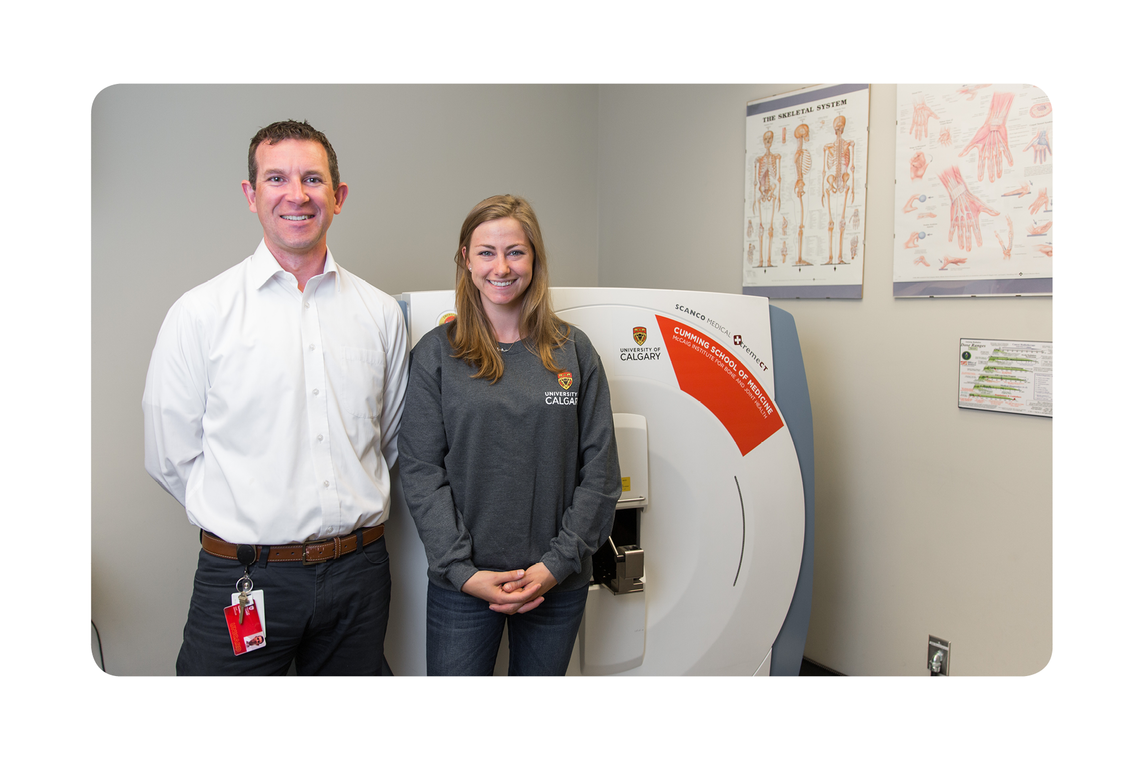Oct. 22, 2018
Participate in Research

NASA astronauts are doing it. So are members of Canada’s national figure skating team.
James Tomasson (BA’00) did it too – he’s a Calgarian who signed up to have his bones scanned as part of a University of Calgary research study on bone health. The 43-year-old decided to participate not long after he started cycle commuting. On his ride home one day, he slipped on some leaves.
“I hurt my elbow so I was a little concerned, not so much that I’d have permanent damage, but I just wanted to reassure myself that my bones are healthy and in good condition, and I wanted a better sense of my baseline fitness level.”
For the study, Tomasson’s ankle and wrist were scanned with an XtremeCT. The state-of-the-art imaging machine generates high-resolution 3D scans that reveal bone micro-structure and quality. The University of Calgary was first in the world to get the machine; there are now three in Canada.
XtremeCT generates a more detailed look at bone architecture than a DXA scan does, which is the current standard bone density scanner, says Dr. Steven Boyd, MSc’97, PhD’01, the study’s principal investigator. He’s a professor at the Schulich School of Engineering and the Cumming School of Medicine, as well as director of the McCaig Institute for Bone and Joint Health, where the study is underway.
Tomasson is a program and event co-ordinator at the McCaig Institute for Bone and Joint Health (but does not work on any of the bone studies).
Anyone ages 18 to 95 who can remain still for about five minutes in the scanner is eligible to apply to participate. Boyd’s goal is to scan 1,000 people who collectively represent the general Calgary population. More than 650 people have been scanned so far.
In any study or clinical trial, recruitment is probably the hardest part, says Boyd.
“People underestimate how difficult recruitment is,” he says. Boyd is hopeful that the University of Calgary’s Participate in Research website can be a useful tool to connect researchers with the general public, and help raise awareness about the importance of recruiting a wide variety of study participants.
Boyd is also using the machine in other studies to look at the bones of Canada’s national figure skating team, astronauts from the Canadian Space Agency and NASA.
It’s one example of the more than 400 research studies and clinical trials actively recruiting the general public through the UCalgary Participate in Research website.

“Our goal with the Participate in Research site is to create public awareness of and advocacy for research,” says Dr. Marcello Tonelli, MD, UCalgary’s associate vice-president (Research). “It’s a way to support researchers by connecting them with the public and also offer the public a unique form of volunteer experience that they might not have even thought of before.”
A number of universities have websites with information about clinical trials or lists of studies for specific subject areas, but the Participate in Research website is one of the first to create a large searchable, cross-discipline database that combines both clinical trials with an even wider variety of studies underway.
Participate in Research not only makes it easy for the public to take part, but researchers too. The proprietary web database draws its information from the university’s existing ethics application software, the Institutional Research Information Services Solution (IRISS), which researchers already use to apply for ethics certification for their research projects.
If you can think of a topic that interests you – such as computer games, exercise, sleeping, gambling, stress, social media, e-cigarettes or dance – visit the website today and like some NASA astronauts, Canada’s national figure skating team and many others, your journey in support of UCalgary research might just get underway.

James Tomasson with graduate student Danielle Whittier in Dr. Stephen Boyd’s lab.



